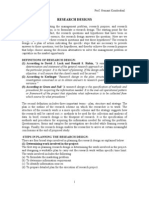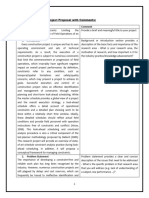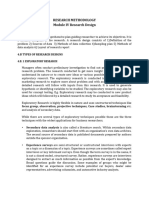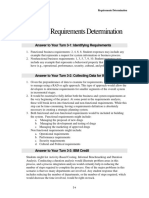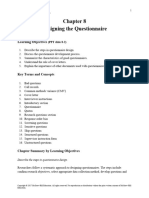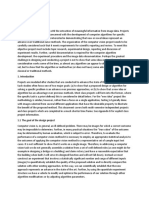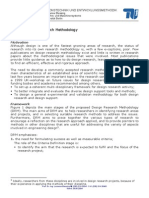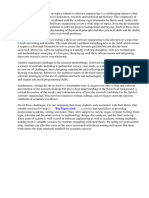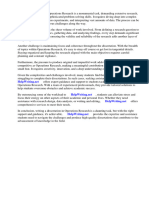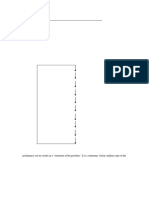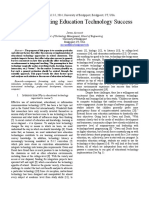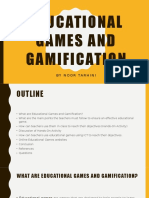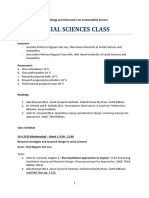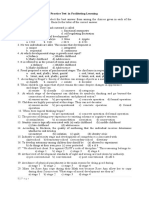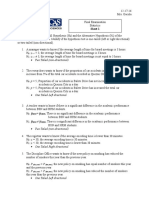2011-0021 22 Research Methodology
2011-0021 22 Research Methodology
Uploaded by
leeCopyright:
Available Formats
2011-0021 22 Research Methodology
2011-0021 22 Research Methodology
Uploaded by
leeOriginal Description:
Original Title
Copyright
Available Formats
Share this document
Did you find this document useful?
Is this content inappropriate?
Copyright:
Available Formats
2011-0021 22 Research Methodology
2011-0021 22 Research Methodology
Uploaded by
leeCopyright:
Available Formats
Topic TheResearch
Design
LEARNING OUTCOMES
By the end of this topic, you should be able to:
1.
Define what is research design;
2.
Elaborate the functions of research design;
3.
Differentiate the good research designs from the weak research
designs; and
4.
Analyse the differences between a true experimental design and a
quasi-experimental design;
INTRODUCTION
This topic focuses on how we carry out analysis on operating activities, by
analysing accrual measures of both revenues and expenses. We will also learn
about the net income analysis. Finally, we are going to learn to distinguish the
components of income and impact for financial analysis.
TOPIC 5 THE RESEARCH DESIGN
5.1
59
WHAT IS A RESEARCH DESIGN?
Say that you have already decided what you want to study. The next question
you should ask yourself is how are you going to conduct your study? What are
the dos and donts in the process of undertaking the research? The answer to this
question comprises the core of a research design.
A research design is a procedural plan that is adopted by a researcher to answer
questions in a valid way. It is very objective and accurate. Normally, a research
design will determine the type of analysis you should carry out to get the desired
results. To what extent your design is good or bad will depend on whether you
are able to get the answers to your research questions. If your design is poor, the
results of the research also will not be promising.
How do you go about getting a good research design that will provide sufficient
answers to your research work? It is not easy and there is no fixed method to tell
others how to do it. The best approach will be to examine different types of
research designs, list down the strengths and weaknesses and then make your
decisions.
As a research student, you should have a good understanding of your
research\problem such as the method that you would like to use in your work,
be clear about your research questions and what is it that you intend to establish.
In ICT, it is always a good practice to understand the technological context
behind every research problem before going in depth. Never select a design and
then try to fit the research questions to the design! It should be the other way
around. It is very important for you to see if the design could answer your
research questions. It is necessary for you to choose a design that will give you
the optimised result over factors that explain the research results obtained.
60
5.2
TOPIC 5 THE RESEARCH DESIGN
THE FUNCTIONS OF RESEARCH DESIGN
A research design relates to the identification of procedures and logistical
arrangements to start a study and also at the same time emphasises the
importance of quality in producing optimised research results. It glues all the
components and subcomponents in a research project together. In typical
experimental research design, there are a few symbols that a researcher should
know which have been widely used to show the design of a study. These
symbols are:
R = Random assignment:subjects are assigned in random and into
various groupings
X = Means treatment, which maybe design and implementation,
performance evaluation, simulation study and so forth
O = Observation or Measurement
( e.g. data rate, baud rate, respond time, bufferring period,etc.)
Generally, we can divide the functions of research design into two:
(a)
Constructing an operational procedure to execute the tasks required in
completing your research work.
(b)
Ensuring these procedures are sufficient to get valid, objective and answers
which are accurate to the questions posed in the research work.
One of the most fundamental aspects of a research design is to specify everything
in depth and clear. This is to ensure that a reader will understand what method
to follow and how to follow it. A research design should have the following:
(i)
Naming the study design (for example as comparative, cross-sectional or
random control)
(ii)
How will the study population be identified?
(iii) What are the sampling methods used ( we will go further about sampling in
the coming topics)?
(iv) What method of data collection will be used in the research work?
(v)
How will ethical issues be considered?
TOPIC 5 THE RESEARCH DESIGN
61
SELF-CHECK 5.1
Identify the two functions of research design.
5.3
WEAK DESIGNS
5.3.1
One-shot Design
Lets say you want to examine whether consumer knowledge makes better
service provision in e-commerce. You measure e-commerce service provision
with the number of transactions. To test this idea, you choose a group of
consumers who use e-commerce for purchasing and these consumers with ecommerce knowledge yield higher transactions rate. You conclude that
consumers with knowledge of e-commerce increases the number of e-commerce
overall transactions. The design is weak for the following reasons:
(a)
Selection Bias: The group you selected as subjects might already have some
fundamental knowledge about e-commerce.
(b)
Background: The organisation of the groups you select might use ecommerce in their daily business transactions, so it might influence the
results.
5.3.2
One-Group Pretest-Posttest Design
Using the same example as above, to ensure that there are no pre-existing
characteristics among the consumers, a pretest may be administered. If the
respondents perform better in e-commerce service provision after being briefed
on e-commerce prior to the pretest, then you can attribute it to the frequency of
briefing. Table 5.1 summarises the reasons why this design is considered weak.
62
TOPIC 5 THE RESEARCH DESIGN
Table 5.1: Reasons why One-Group Pretest-Posttest Design is weak
Reason
Explaination
(a)
Maturation
If the time gap between the pretest and posttest is
long, it is possible that the subjects may have
matured due to developmental changes and
modification.
(b)
Testing
Sometimes the time gap between pretest and
posttest is too short and there is possibility that
subjects cannot recall on e-commerce usage
methodology.
SELF-CHECK 5.2
1.
Identify the differences between one-shot design and one-group
pretest-posttest design.
2.
Why are these designs considered weak?
5.4
TRUE DESIGNS
It is important for us to look into true experimental designs or widely known as
true designs in research methodology. In true designs, a researcher should
have a research design that enables him/her to have control over the situation in
terms of assignment of subjects into groups, to decide on who gets the treatment
condition and to decide the amount of treatment condition that subjects receive
(Christensen 1988). In this topic, we will discuss two major types of true design
after-only and before-after. The major difference between these two designs is
that:
(a)
the after-only design depends on posttest
(b)
before-and-after design depends on a pretest and a posttest.
TOPIC 5 THE RESEARCH DESIGN
5.4.1
63
The After-only Design
In this design, let us say that a researcher is aware that a population is exposed to an
intervention. Therefore, he/she wishes to study its impact on the population. In this
design, pretest is usually constructed based on situation before an intervention; or
from information available from existing record. In the ICT, after-only-design is
often used in system verification based research and at times in design and
implementation procedures. Figure 5.1 shows the after-only design.
Figure 5.2 : The After-Only Design
Source: Adapted from Figure 8.7 Research Methodology: Ranjit Kumar, page 102
This design is mainly used in IT impact assessment studies. In real-life, many
programmes operate without the benefit of a planned evaluation at the
programme planning stage. This is due to the fast changing nature of the ICT
field and it is not possible to follow strictly the sequence such as collection of
baseline information, implementation of programme and then programme
evaluation. In normal practice, the adequacy of this design relies on the accuracy
of data obtained on the prevalence of incident or impact before an intervention is
introduced. Let us take a look at a few examples of situations.
(a)
the impact of web services in e-commerce technology;
(b)
the impact of decline in network performance of a campus WAN; or
(c)
the impact of IT on undergraduate education.
In these types of situations, it is expected that accurate details are kept regarding
the scope of the study. Therefore, any change is due to the introduction of
intervention or policy changes of the research issue.
64
TOPIC 5 THE RESEARCH DESIGN
5.4.2
The Before-and-after Design
One of the good examples of true design is the before-and-after research design.
This includes experimental and control groups. This design overcomes the
problem of retrospectively constructing the before observation by introducing it
before the intervention takes place in the research subject. This design solves the
problem with after-only design that is comparative of the before-and-after
observations (Figure 5.2).
Figure 5.2: Measurement of change through a before-and-after design
SELF-CHECK 5.3
1.
What is the core strength of true designs in research?
2.
What is the major difference between the two types of true design
discussed in this section?
5.5
THE QUASI-EXPERIMENTAL DESIGN
What is meant by Quasi-Experimental Design?
Quasi-Experimental Design is a design that does not provide full
scalable control towards confounding variables.
~ Chirstensen and Johnson 2000
TOPIC 5 THE RESEARCH DESIGN
65
This could be due to random assignment of samples in a particular study. In
some cases, it is not possible to assign samples to groups which require a strong
experimental research.
For example, in ICT, there are times when researchers faced with situation where
all the requirements of a true design experiment cannot be fulfilled. This scenario
is particularly true when dealing with IT impact based research and studies.
5.5.1
Non-Equivalent Control Group Design
This design group contains both experimental and control groups. However,
subjects are not randomly assigned to the groups. This means that the subjects in
the groups may not be equivalent on all variables defined. In this design, both
groups are given first a pretest and then a posttest (once the treatment is given to
the experimental group). Both scores of posttest and pretest are compared to each
other to check if there is any significant differences. Figure 5.3 below shows the
non-equivalent control group design.
Figure 5.3: Non-Equivalent Control Group Design
Source: Adapted from www.socialresearchmethods.net
We must know here that we cannot randomly assign subjects, it means we can be
sure that extraneous variables or factors will creep into our experiment and
threaten its internal validity (we will discuss in depth about validity in the
coming topics). A good researcher will take some measures in ensuring the
subjects in the experimental and control groups are as similar as possible. In ICT
research, it might be important variables such as infrastructure, technology
feasibility, ICT testbed and so forth.
5.5.2
Interrupted Time Series Design
This design requires a researcher to take a series of measurements both before
and after the treatment. A good example of deployment of this research design is
ICT communication research and performance modelling of network. Subjects
from a single group will be pretested a number of times during the foundation
66
TOPIC 5 THE RESEARCH DESIGN
phase, exposed to the treatment, and then posted a number of times after the
treatment (Figure 5.4). Foundation phase refers to the testing conducted before
the treatment to alter behaviour.
Figure 5.4: Interrupted Time-Series Design
Source: Adapted from www.socialresearchmethods.net
SELF-CHECK 5.4
1.
What is the meaning of quasi-experimental design?
2.
What is defined as non-equivalent control group design?
ACTIVITY 5.1
To learn more about Quasi-Experimental design, visit the following
website: http://www.socialresearchmethods.net/kb/quasiexp.php
http://allpsych.com/researchmethods/quasiexperimentaldesign.html
What did you learn from your readings? Share your thoughts on lessons
learned from this topic with your coursemates. Post your comments in the
myLMS forum. Remember, sharing is caring!
A research design consists of strategy and specific procedures in seeking
answers to a specific research question.
A weak research design does not allow controlling extraneous variables into
experiment.
Some examples of weak designs are one-shot design and one-group pretestposttest design
A true research design allows us to maintain control over a situation in terms
of variables assignment.
TOPIC 5 THE RESEARCH DESIGN
67
A quasi-experimental design is a design that does not provide full control
over variables.
Examples of quasi-esperimental design are non-equivalent control group
design and interrupted time-series.
Experimental design
Quasi experimental design
Non-equivalent design
Interrupted time series design
Weak Research design
True design
After only design
Before-and-after design
1.
Construct a research case for a true experimental design in ICT.
2.
What are Quasi-experimental research designs? How do they
differ from true experiments?
Books
Christensen, L. (1988). Experimental methodology. Boston: Allyn and Bacon Inc.
Mitchell, M., & Jolley, J. (1988). Research design explained. New York: Holt,
Rinehart & Winston.
Internet Resources
Trochim, W. K. (2007). Research method tutorials [Electronic version]
http://www.socialresearchmethods.net/tutorial/tutorial.htm
Vagner , K. W. (2007). Introduction to research methods [Electronic version]
http://psychology.about.com/od/researchmethods/ss/expdesintro.htm
You might also like
- Research Paper Proposal TemplateDocument3 pagesResearch Paper Proposal TemplatePablo MoralesNo ratings yet
- Research DesignDocument10 pagesResearch DesignBalaji N92% (13)
- BS Entrep FeasibilityDocument41 pagesBS Entrep Feasibilitymaranatha rallosNo ratings yet
- Sports Tourism Syllabus FinalDocument14 pagesSports Tourism Syllabus FinalJay R BayaniNo ratings yet
- Main Documentation ChaptersDocument11 pagesMain Documentation ChaptersBeiAoRuiNo ratings yet
- Exercise 2Document4 pagesExercise 2Ayushi JainNo ratings yet
- Chapter TwoDocument12 pagesChapter TwoSolomon TetekaNo ratings yet
- A Sample Proposal With CommentsDocument4 pagesA Sample Proposal With CommentsRobert Malusher MwandoeNo ratings yet
- Week 2 - A Sample of A Short Research ProposalDocument4 pagesWeek 2 - A Sample of A Short Research ProposalIsrael PopeNo ratings yet
- Research MethodologyDocument19 pagesResearch MethodologyAdil SayaNo ratings yet
- Solved Assignments of SMU MBA Semester 3 Summer 2014 Are Available.Document4 pagesSolved Assignments of SMU MBA Semester 3 Summer 2014 Are Available.Rajdeep KumarNo ratings yet
- Sample Proposal With CommentDocument3 pagesSample Proposal With CommentarulgasparNo ratings yet
- Activity 1 - SolutionsDocument7 pagesActivity 1 - Solutionsomaralmutawa1No ratings yet
- Chapter 2 Define TaskDocument66 pagesChapter 2 Define TaskwanpudinNo ratings yet
- Research Paper Latest TemplateDocument4 pagesResearch Paper Latest TemplateDaniel JohnsNo ratings yet
- Module 4 - Research DesignDocument8 pagesModule 4 - Research DesignUNNATI SHUKLANo ratings yet
- N5E01 Hints 2101317 Revised On 27 Mar 2021Document4 pagesN5E01 Hints 2101317 Revised On 27 Mar 2021yusong32No ratings yet
- A Sample Proposal With CommentDocument3 pagesA Sample Proposal With CommentEmmanuel Kwesi ArthurNo ratings yet
- MMD101 ModelAnswerDocument6 pagesMMD101 ModelAnswerVishal JangirNo ratings yet
- Chapter One Software Engineering Practice: The Essence of PracticeDocument9 pagesChapter One Software Engineering Practice: The Essence of PracticeAbdurahmanNo ratings yet
- Why-Is-A-System-Proposal-So-Crucial-For-System-Design 2Document3 pagesWhy-Is-A-System-Proposal-So-Crucial-For-System-Design 2GlobeNo ratings yet
- Simulation Guide For USA12Document6 pagesSimulation Guide For USA12dilbertdaveNo ratings yet
- Research Process-Problem Defination RevisedDocument12 pagesResearch Process-Problem Defination Revisedkevin YegoNo ratings yet
- Chapter 3 SolutionsDocument16 pagesChapter 3 SolutionsPrabhjot SinghNo ratings yet
- Bcs Higher Education Qualifications BCS Level 6 Professional Graduate Diploma in ITDocument12 pagesBcs Higher Education Qualifications BCS Level 6 Professional Graduate Diploma in ITRonald Nyathi100% (1)
- Hair 4e IM Ch08Document19 pagesHair 4e IM Ch08JB VallegaNo ratings yet
- A Sample Proposal With Comment SLSMLSDocument5 pagesA Sample Proposal With Comment SLSMLSRavi KumudeshNo ratings yet
- A Sample Proposal With CommentDocument3 pagesA Sample Proposal With CommentramszlaiNo ratings yet
- System PlanningDocument30 pagesSystem Planningxingjie265No ratings yet
- A Sample Proposal With CommentDocument3 pagesA Sample Proposal With CommentTien PhanNo ratings yet
- A Sample Proposal With CommentDocument3 pagesA Sample Proposal With CommentNaqi MuttaqiNo ratings yet
- The Computer Vision ProjectDocument6 pagesThe Computer Vision ProjectYonsNo ratings yet
- Ignou Ms-95 Solved Assignment June - 2013Document19 pagesIgnou Ms-95 Solved Assignment June - 2013Amit Kumar SinghNo ratings yet
- Chapter 2 Research and DesignDocument24 pagesChapter 2 Research and Designalvin salesNo ratings yet
- Chapter 3. Requirements DeterminationDocument12 pagesChapter 3. Requirements DeterminationEugine CasañadaNo ratings yet
- A Sample Research Proposal With CommentsDocument3 pagesA Sample Research Proposal With CommentsUmesha SavindiNo ratings yet
- PHD Thesis Results SectionDocument6 pagesPHD Thesis Results SectionCrystal Sanchez100% (2)
- Finalized Research Guideline of Bachelor of Science in Computer ScienceDocument8 pagesFinalized Research Guideline of Bachelor of Science in Computer ScienceethicalfantasyNo ratings yet
- Lean Principles, Learning, and Knowledge Work: Evidence From A Software Services ProviderDocument9 pagesLean Principles, Learning, and Knowledge Work: Evidence From A Software Services ProviderAnirban ChakrabortyNo ratings yet
- ArtificialDocument5 pagesArtificialAadithya RSNo ratings yet
- Class 12 AI - Unit 1Document10 pagesClass 12 AI - Unit 1SahanaaNo ratings yet
- Software Engineering: PracticeDocument11 pagesSoftware Engineering: PracticeBhargav VangaraNo ratings yet
- Homework 15.11.2023Document6 pagesHomework 15.11.2023vidmaev168No ratings yet
- Unit 3 Research Design: ObjectivesDocument19 pagesUnit 3 Research Design: ObjectivesPankaj GuptaNo ratings yet
- DRM: A Design Research Methodology: MotivationDocument4 pagesDRM: A Design Research Methodology: Motivationaustin007No ratings yet
- Research Paper Topics For Software EngineeringDocument5 pagesResearch Paper Topics For Software Engineeringwroworplg100% (1)
- 11 Credible Valid ModelsDocument9 pages11 Credible Valid ModelsRoopa MurthyNo ratings yet
- IGNOU MBA MS-95 Solved 2013 PDFDocument19 pagesIGNOU MBA MS-95 Solved 2013 PDFsree0020No ratings yet
- Dissertation Operations ResearchDocument7 pagesDissertation Operations ResearchPayToWritePapersSingapore100% (1)
- Instructional Development ModelsDocument33 pagesInstructional Development ModelsCristina Natividad EstolanoNo ratings yet
- Topic 9 SYSTEMS DEVELOPMENT LIFE CYCLE SDLCDocument14 pagesTopic 9 SYSTEMS DEVELOPMENT LIFE CYCLE SDLCVictor ZwalimwaNo ratings yet
- A Survey of Architecture Design RationaleDocument46 pagesA Survey of Architecture Design RationaleEdward CardenasNo ratings yet
- Steven Pascal SDLC G12Document128 pagesSteven Pascal SDLC G12valariesimwanza192No ratings yet
- Minor ProjectDocument51 pagesMinor ProjectShekhar KumarNo ratings yet
- IM Appendix B UCL Conceptual Design Ed12Document36 pagesIM Appendix B UCL Conceptual Design Ed12Chong Fong KimNo ratings yet
- Software Engineering CatDocument5 pagesSoftware Engineering CatjeffNo ratings yet
- Group Project Software Management: A Guide for University Students and InstructorsFrom EverandGroup Project Software Management: A Guide for University Students and InstructorsNo ratings yet
- The Complete Project Management Exam Checklist: 500 Practical Questions & Answers for Exam Preparation and Professional Certification: 500 Practical Questions & Answers for Exam Preparation and Professional CertificationFrom EverandThe Complete Project Management Exam Checklist: 500 Practical Questions & Answers for Exam Preparation and Professional Certification: 500 Practical Questions & Answers for Exam Preparation and Professional CertificationNo ratings yet
- Implementing the Stakeholder Based Goal-Question-Metric (Gqm) Measurement Model for Software ProjectsFrom EverandImplementing the Stakeholder Based Goal-Question-Metric (Gqm) Measurement Model for Software ProjectsNo ratings yet
- Building Options at Project Front-End Strategizing: The Power of Capital Design for EvolvabilityFrom EverandBuilding Options at Project Front-End Strategizing: The Power of Capital Design for EvolvabilityNo ratings yet
- Factors Affecting Education Tech SuccessDocument6 pagesFactors Affecting Education Tech SuccessleeNo ratings yet
- Graphic Materials & Short Texts: The Dangers of RadiationDocument1 pageGraphic Materials & Short Texts: The Dangers of RadiationleeNo ratings yet
- Us4 2B 2015Document8 pagesUs4 2B 2015leeNo ratings yet
- Phrasal Verbs and Idomatic Expressions: List of More Phrasal Verbs No Phrasal Verb ExampleDocument2 pagesPhrasal Verbs and Idomatic Expressions: List of More Phrasal Verbs No Phrasal Verb ExampleleeNo ratings yet
- Happy Birthday To YouDocument3 pagesHappy Birthday To YouleeNo ratings yet
- Mem 1Document63 pagesMem 1danarasmussenNo ratings yet
- Lesson Plan - SandraDocument5 pagesLesson Plan - Sandraapi-251465870No ratings yet
- Factors That Affect Information and Communication Technology Usage: A Case Study in Management EducationDocument20 pagesFactors That Affect Information and Communication Technology Usage: A Case Study in Management EducationTrần Huy Anh ĐứcNo ratings yet
- Syllabus AOADocument4 pagesSyllabus AOAPallavi RaiturkarNo ratings yet
- Educational Games and GamificationDocument14 pagesEducational Games and Gamificationapi-319480328No ratings yet
- The Code of Ethics On Standardized TestingDocument4 pagesThe Code of Ethics On Standardized Testingmiera_2014No ratings yet
- Appendix Social Science ClassDocument3 pagesAppendix Social Science ClassHương Giang NguyễnNo ratings yet
- Social Movements SyllabusDocument6 pagesSocial Movements SyllabusWendy M. Christensen, Ph.D.No ratings yet
- 6 Math Tournament Identify and ModifyDocument3 pages6 Math Tournament Identify and Modifyapi-349916631No ratings yet
- Public School SystemDocument13 pagesPublic School SystemjrodNo ratings yet
- Multicultural CurriculumDocument14 pagesMulticultural CurriculumJaymar MagtibayNo ratings yet
- Naeyc Standard 3 FinalDocument1 pageNaeyc Standard 3 Finalapi-266196074No ratings yet
- Understanding The Self Psych 1A: Name: Marinette R. Parra Year & Section: - BSE-FILIPINO 1-2Document4 pagesUnderstanding The Self Psych 1A: Name: Marinette R. Parra Year & Section: - BSE-FILIPINO 1-2Marinette Parra100% (1)
- Extended Resume FolgerDocument6 pagesExtended Resume Folgerapi-237411835No ratings yet
- PDR 3 - Learning Disabilities Annotated BibliographyDocument4 pagesPDR 3 - Learning Disabilities Annotated Bibliographyapi-313083387No ratings yet
- Facilitating of LearningDocument8 pagesFacilitating of LearningJoshua MagpantayNo ratings yet
- English Project 2 Part 2Document11 pagesEnglish Project 2 Part 2LeeYates34No ratings yet
- Vistas #9, December 18, 2015Document12 pagesVistas #9, December 18, 2015vvaccountsNo ratings yet
- Final Exam Sheet 1Document1 pageFinal Exam Sheet 1RosemariePletadoNo ratings yet
- MTB Mle LiteracyDocument4 pagesMTB Mle Literacyror Wie100% (1)
- Word StudyDocument8 pagesWord Studyapi-207064250No ratings yet
- Role Supports Mission VisionDocument3 pagesRole Supports Mission Visionapi-508564949No ratings yet
- Extractin Information LPDocument2 pagesExtractin Information LPAristotle TomasNo ratings yet
- Oas Community College-EapDocument2 pagesOas Community College-EapMerida BravoNo ratings yet
- Testing Communicative CompetenceDocument3 pagesTesting Communicative CompetenceMercy Grace LupoNo ratings yet
- Gaurav Indoria: Area of Interest EducationDocument1 pageGaurav Indoria: Area of Interest EducationGaurav IndoriaNo ratings yet
- DLL - MTB 3 - Q3 - W9Document3 pagesDLL - MTB 3 - Q3 - W9Krystel Monica ManaloNo ratings yet
- Tracer StudyDocument17 pagesTracer StudyJoiche Itallo Luna100% (4)

